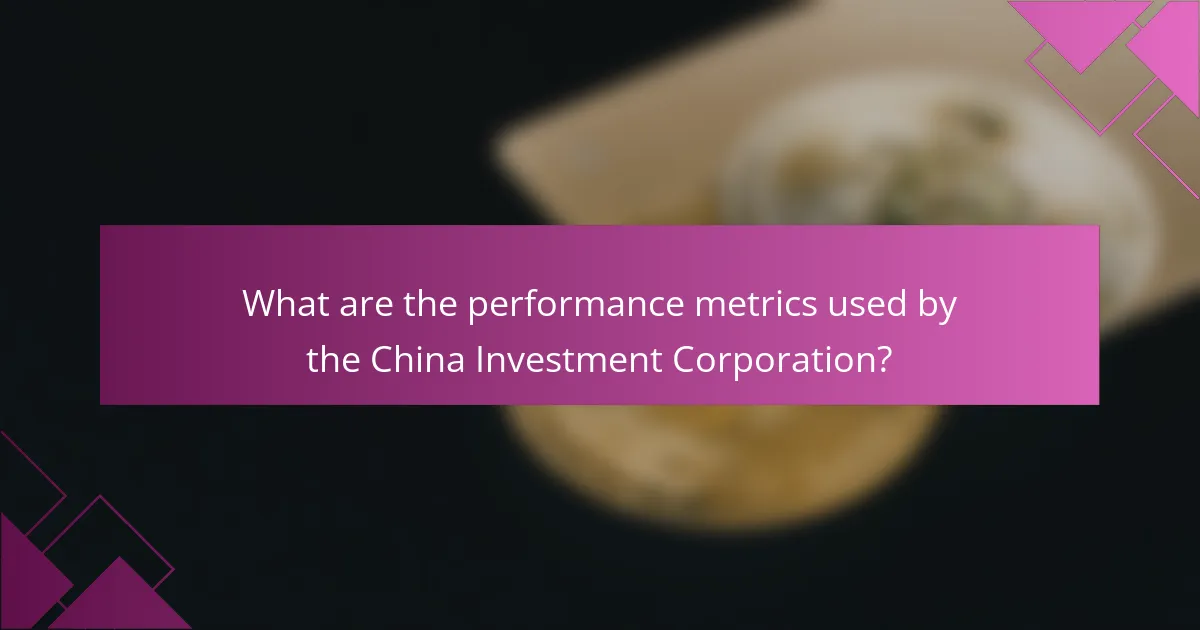
What is the China Investment Corporation (CIC)?
The China Investment Corporation (CIC) is a sovereign wealth fund established by the Chinese government in 2007. Its primary purpose is to manage and diversify China’s foreign exchange reserves. The CIC invests in various asset classes, including equities, fixed income, real estate, and alternative investments. With an estimated asset value exceeding $1 trillion, it is one of the largest sovereign wealth funds globally. The CIC aims to achieve long-term capital appreciation while enhancing China’s global economic influence. Its investment strategy includes partnerships with foreign investment firms and direct investments in strategic sectors.
How was the China Investment Corporation established?
The China Investment Corporation (CIC) was established on September 29, 2007. It was created to diversify China’s foreign exchange holdings. The CIC was formed as a response to the growing need for a professional investment management institution. The Chinese government aimed to enhance the country’s investment capabilities. The establishment was part of a broader strategy to manage the nation’s foreign assets effectively. The CIC was funded with an initial capital of $200 billion. It operates under the State Council of China. The corporation’s creation reflects China’s increasing role in global financial markets.
What are the primary objectives of the China Investment Corporation?
The primary objectives of the China Investment Corporation (CIC) are to diversify China’s foreign investment portfolio and enhance its returns. CIC aims to manage and invest part of China’s foreign exchange reserves. It focuses on long-term financial returns through investments in various asset classes. These include public equities, fixed income, and alternative investments. The CIC also seeks to promote the stability of China’s financial system. Additionally, it aims to support the country’s economic growth by investing in strategic sectors. The CIC was established in 2007, reflecting China’s growing need for global investment strategies. Its performance metrics are closely monitored to ensure alignment with national economic goals.
What is the governance structure of the China Investment Corporation?
The governance structure of the China Investment Corporation (CIC) consists of a board of directors and a supervisory board. The board of directors oversees the overall management and strategic direction of the CIC. It is responsible for approving major investment decisions and policies. The supervisory board monitors the operations and ensures compliance with regulations. The CIC is directly under the State Council of China, which provides guidance and oversight. This structure ensures accountability and aligns the CIC’s objectives with national interests. The governance framework is designed to enhance transparency and efficiency in investment operations.
What role does the CIC play in global markets?
The China Investment Corporation (CIC) plays a significant role in global markets by investing in various asset classes worldwide. Established in 2007, CIC manages China’s foreign exchange reserves and aims to diversify its investment portfolio. The corporation focuses on long-term returns while enhancing China’s economic influence globally. It invests in equities, fixed income, real estate, and alternative assets across different regions. As of 2021, CIC’s assets under management exceeded $1 trillion, making it one of the largest sovereign wealth funds globally. Its strategic investments often target infrastructure, technology, and energy sectors, aligning with China’s Belt and Road Initiative. Through these investments, CIC fosters international partnerships and promotes economic growth.
How does the CIC influence international investment trends?
The China Investment Corporation (CIC) influences international investment trends by allocating significant capital to diverse global assets. As one of the largest sovereign wealth funds, it impacts market dynamics through its investment choices. The CIC focuses on sectors like technology, energy, and infrastructure, driving interest in these areas. Its investments can enhance liquidity and attract other investors to similar markets. For instance, the CIC’s investment in the U.S. technology sector has encouraged further foreign investment. Additionally, its strategic partnerships with global firms foster collaboration and innovation. The CIC’s approach often reflects China’s broader economic objectives, aligning investments with national priorities. This alignment can shape global investment strategies, as other entities may follow the CIC’s lead.
What are the key sectors targeted by the CIC in global markets?
The key sectors targeted by the China Investment Corporation (CIC) in global markets include energy, technology, healthcare, and financial services. In the energy sector, CIC invests in renewable energy and traditional resources to diversify its portfolio. The technology sector sees investments in IT, telecommunications, and emerging technologies like artificial intelligence. In healthcare, CIC focuses on pharmaceuticals and biotechnology to capitalize on global health trends. The financial services sector includes investments in private equity and infrastructure projects. These targeted sectors align with China’s strategic economic goals and provide growth opportunities for CIC’s investments.

What are the performance metrics used by the China Investment Corporation?
The performance metrics used by the China Investment Corporation (CIC) include total return, risk-adjusted return, and benchmark comparisons. Total return measures the overall profitability of investments over a specific period. Risk-adjusted return evaluates the performance relative to the risk taken. Benchmark comparisons assess CIC’s performance against relevant market indices or peer funds. These metrics help in evaluating the effectiveness of CIC’s investment strategies. They also provide insights into the organization’s ability to meet its financial objectives.
How does the CIC measure investment success?
The China Investment Corporation (CIC) measures investment success through several key performance metrics. These metrics include financial returns, risk-adjusted returns, and portfolio diversification. Financial returns are assessed by comparing the performance of investments against benchmarks. Risk-adjusted returns evaluate how much return is generated for each unit of risk taken. Portfolio diversification is analyzed to ensure a spread of investments across various sectors and geographies. The CIC also considers long-term strategic value in its investments. This approach aligns with its mandate to achieve sustainable growth and stability.
What financial indicators are most relevant to the CIC’s performance?
The most relevant financial indicators for the China Investment Corporation’s (CIC) performance include total assets under management, return on investment (ROI), and net income. Total assets under management reflect the scale and capacity of CIC’s investment portfolio. ROI measures the profitability of investments, indicating how effectively CIC generates returns. Net income provides insight into the overall financial health and operational efficiency of the organization. These indicators are critical for assessing CIC’s success in achieving its strategic objectives in global markets.
How does the CIC compare its performance to global benchmarks?
The China Investment Corporation (CIC) evaluates its performance against global benchmarks by utilizing various financial metrics. These metrics include return on investment (ROI), asset allocation performance, and risk-adjusted returns. The CIC compares its annual returns to those of major sovereign wealth funds and global investment indices. For instance, in 2022, the CIC reported a 6.5% return, which it measured against the 5.9% average return of other sovereign wealth funds. This comparison helps the CIC assess its competitive position in the global market. Additionally, the CIC employs third-party evaluations to validate its performance metrics. These evaluations provide an objective measure of how its investment strategies align with global standards.
What challenges does the CIC face in performance measurement?
The China Investment Corporation (CIC) faces several challenges in performance measurement. One significant challenge is the complexity of global investment environments. This complexity arises from varying economic conditions across different countries. Additionally, the CIC must navigate diverse regulatory frameworks that impact investment performance. Another challenge is the difficulty in establishing consistent benchmarks for performance comparison. The CIC often invests in unique assets that lack standard metrics. Furthermore, the long-term nature of many investments complicates immediate performance assessments. Fluctuating currency exchange rates also pose a challenge in evaluating returns. Lastly, the CIC must account for geopolitical risks that can affect investment outcomes. These factors collectively hinder the CIC’s ability to measure performance accurately and consistently.
How do geopolitical factors impact the CIC’s performance metrics?
Geopolitical factors significantly impact the China Investment Corporation’s (CIC) performance metrics. These factors influence investment decisions and risk assessments. Political stability in host countries affects CIC’s investment returns. Economic sanctions or trade wars can limit access to certain markets. Changes in regulatory environments can alter the viability of investments. For instance, tensions between China and the U.S. have led to increased scrutiny of Chinese investments abroad. This scrutiny can result in lower investment volumes and increased costs for the CIC. Additionally, geopolitical alliances can create opportunities for strategic partnerships. Overall, geopolitical dynamics play a crucial role in shaping the CIC’s operational landscape and performance outcomes.
What role does market volatility play in assessing the CIC’s success?
Market volatility significantly impacts the assessment of the China Investment Corporation’s (CIC) success. High volatility can lead to unpredictable returns on investments. This unpredictability complicates performance evaluations over specific periods. Analysts often use volatility metrics to gauge risk associated with CIC’s investment strategies. For instance, a higher volatility may indicate greater risk but also potential for higher returns. Historical data shows that during periods of increased market volatility, the CIC has adjusted its portfolio to mitigate risks and capitalize on opportunities. This adaptability reflects the CIC’s strategic approach in navigating fluctuating markets. Therefore, market volatility serves as a critical factor in evaluating the CIC’s effectiveness in achieving its investment objectives.

What strategic investments has the China Investment Corporation made?
The China Investment Corporation (CIC) has made significant strategic investments across various sectors globally. Notable investments include stakes in major financial institutions such as Blackstone Group and Morgan Stanley. CIC has also invested in energy companies like the Canadian oil sands and various renewable energy projects. The corporation has diversified its portfolio with investments in technology firms, including Alibaba and Tencent. Additionally, CIC has engaged in real estate investments in major cities worldwide. These strategic moves aim to enhance China’s economic influence and secure stable returns.
What are some notable investments made by the CIC?
The China Investment Corporation (CIC) has made several notable investments globally. One significant investment is in Blackstone Group, where CIC invested $3 billion in 2007. This investment has yielded substantial returns over the years. Another prominent investment is the $1 billion stake in Morgan Stanley, acquired in 2007. This partnership has allowed CIC to gain insights into global financial markets. Additionally, CIC invested $1.5 billion in the Canadian oil sands through a partnership with Athabasca Oil Corporation in 2012. This move reflects CIC’s strategy to diversify its portfolio in natural resources. In 2016, CIC also invested $1.2 billion in the logistics company Logicor, enhancing its presence in European infrastructure. These investments illustrate CIC’s strategic approach to global market engagement and asset diversification.
How have these investments shaped the CIC’s portfolio?
The investments have significantly diversified the China Investment Corporation’s (CIC) portfolio. By allocating capital across various sectors and geographies, the CIC has reduced risk exposure. Investments in technology, renewable energy, and infrastructure have enhanced growth potential. The portfolio now includes significant stakes in global companies. This strategic diversification has improved overall returns. For instance, the CIC reported a 10.5% annualized return over a five-year period. This performance showcases the effectiveness of its investment strategy. The CIC’s focus on sustainable assets reflects a commitment to future growth.
What criteria does the CIC use to select strategic investments?
The China Investment Corporation (CIC) uses several criteria to select strategic investments. These criteria include potential for sustainable returns, alignment with national economic goals, and risk management. The CIC evaluates the long-term growth prospects of the investment. It also considers the geopolitical landscape and market trends. Additionally, the CIC assesses the management capabilities of target companies. The organization prioritizes sectors that support China’s economic transformation. This approach ensures that investments contribute to both financial returns and national interests.
How does the CIC adapt its investment strategy over time?
The China Investment Corporation (CIC) adapts its investment strategy over time by analyzing global market trends and economic forecasts. This adaptive strategy involves reassessing asset allocations based on changing financial landscapes. The CIC regularly conducts risk assessments to identify potential opportunities and threats. It also adjusts its investment focus in response to geopolitical events and regulatory changes. Historical performance data guides the CIC in refining its approach. For instance, during economic downturns, the CIC may shift towards more stable, lower-risk investments. In contrast, in a booming market, it might pursue higher-risk, higher-reward opportunities. The CIC’s flexibility allows it to remain competitive in the global market.
What lessons has the CIC learned from past investment successes and failures?
The China Investment Corporation (CIC) has learned several lessons from past investment successes and failures. One key lesson is the importance of diversification. By spreading investments across various sectors and geographies, CIC mitigates risks associated with market volatility. Another lesson is the value of thorough due diligence. Comprehensive analysis of potential investments leads to better decision-making and reduces the likelihood of poor outcomes.
CIC has also recognized the significance of aligning investments with long-term strategic goals. This approach ensures that investments contribute to sustainable growth rather than short-term gains. Additionally, the organization has learned to adapt to changing market conditions. Flexibility in investment strategies allows CIC to respond effectively to global economic shifts.
Furthermore, CIC emphasizes the need for strong partnerships. Collaborating with experienced local firms enhances market entry and operational efficiency. Lastly, the importance of performance evaluation has been highlighted. Regular assessment of investment outcomes informs future strategies and improves overall performance. These lessons guide CIC in refining its investment approach and enhancing its global market presence.
How does the CIC respond to changing global economic conditions?
The China Investment Corporation (CIC) responds to changing global economic conditions by adjusting its investment strategies. It actively reallocates assets to mitigate risks associated with economic fluctuations. The CIC monitors global market trends and economic indicators closely. This helps the CIC identify opportunities in emerging markets. In response to economic downturns, the CIC may increase its focus on stable, low-risk investments. Conversely, during economic upswings, it seeks higher returns through more aggressive investments. Historical data shows that the CIC has diversified its portfolio in response to market volatility. For instance, during the 2008 financial crisis, the CIC shifted investments towards commodities and infrastructure. This adaptability enhances its resilience against global economic shifts.
What best practices can be derived from the CIC’s investment strategy?
The best practices derived from the China Investment Corporation’s (CIC) investment strategy include diversification, long-term investment focus, and risk management. Diversification helps mitigate risks by spreading investments across various asset classes and geographical regions. The CIC emphasizes long-term investment, aiming for sustainable growth rather than short-term gains. This approach allows for better resilience against market volatility. Additionally, the CIC employs robust risk management frameworks, assessing potential risks before making investment decisions. These practices contribute to the CIC’s reputation as a strategic investor on the global stage.
The China Investment Corporation (CIC) is a sovereign wealth fund established in 2007 to manage and diversify China’s foreign exchange reserves, with assets exceeding $1 trillion. The article explores the CIC’s governance structure, investment strategies, and performance metrics, highlighting its role in global markets and the key sectors it targets, such as technology and energy. Additionally, it examines the challenges the CIC faces in performance measurement, the influence of geopolitical factors, and the lessons learned from past investment successes and failures. The article concludes by outlining best practices derived from the CIC’s strategic approach to investing.
